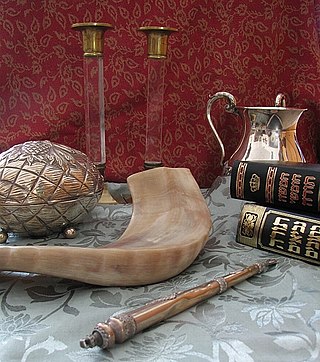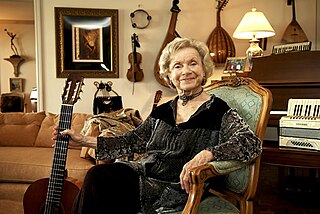Career
Scholarship
There is a Spanish singer who claimed to be singing "an eleventh century Sephardic lullaby". Well, first of all, no one was writing down lullaby melodies – or almost any melodies except early church plainchant – in the eleventh century. And there was no such language as 'Spanish' then – much less Judeo-Spanish. The Judeo-Spanish of the songs people hear is a diaspora language.
–Judith R. Cohen [6]
Cohen is noted as one of the first scholars to develop a specialty in the traditional music of the Sephardic Jewish diaspora. [4] She has received numerous research and travel grants enabling her to study Judeo-Spanish folk music traditions in Spain and among Crypto-Jews in villages in Portugal; other grants have funded her fieldwork in Morocco, Israel, Turkey, Greece, France, Belgium, Canada, and the United States. [5] [12] She has made an effort to dispel the popular myth that Sephardic songs have medieval origins and are unique to Sephardic Jews. She explains that the majority of Judeo-Spanish songs were composed after the expulsion of Jews from Spain, and that both melodies and instrumentation were often borrowed from the neighboring non-Jewish culture. [6]
Among Cohen's research topics is how Judeo-Spanish songs and customs have been incorporated into modern-day festivals, such as the Festa da Istoria in Ribadavia, Galicia, Spain and the "Jewish Festival" in Hervás, Extremadura, Spain. [5] She has also branched out into studies of gender roles in Judeo-Spanish song and Iberian women's drumming. [5] Her fieldwork among Crypto-Jews in communities such as Belmonte and Trás-os-Montes is more circumspect due to the secrecy and suspicion engrained in their lifestyle. [5] Having befriended several families, she and her daughter have been invited to share meals with them, join their prayers (though not to record them), and participate in Passover celebrations. [5] As part of her fieldwork, Cohen also solicits non-Jews for their opinions about Jews and their country's musical traditions. [5]
Cohen's research work extends to medieval music, traditional music from the Balkans and French-Canada, and pan-European balladry. [6] In 2000, Cohen began studying Alan Lomax's Spanish folk-music recordings from 1952. She traveled to Spain to do field research and recorded and interviewed many of the singers (or their descendants) that Lomax had taped. [4] In 2011, Cohen won the first Alan Lomax Fellowship in Folklife Studies from the Library of Congress to prepare Lomax's 1952 fieldwork diary for publication. [4] She is now the editor of the Lomax Spanish collection maintained by the Association for Cultural Equity. She has written detailed liner notes for CD collections of Lomax's dance tunes and ballads from many regions of Spain under the Franco regime. [4]
The Judith R. Cohen Collection at the United States Holocaust Memorial Museum contains "digital sound recordings of English and Ladino songs, oral testimony, radio programs, and academic presentation examples" which Cohen compiled in her research of the Sephardic refugee community in Montreal. [13]
Cohen has presented papers at many international conferences. [4] [14] She was the keynote speaker for the 2004 conference of the International Society for the Study of Medievalism. [14]
Teaching
Cohen was a part-time lecturer at Concordia University from 1977 to 1981. [12] In 1981, she produced a Manual of Early Medieval Music Notation for a course taught by Professor Wolfgang Bottenberg at Concordia. [15] Cohen taught medieval music at The Royal Conservatory of Music in Toronto from 1983 to 1988, and worked as an itinerant music instructor in recorder for the Toronto Board of Education from 1986 to 1990. [1] [12]
Cohen joined the faculty of York University as a part-time instructor in 1990. [4] Since 1993, she has been a member of the Adjunct Graduate Faculty of the Department of Music. [12] She has taught courses in music history and directed a Renaissance and medieval ensemble and a world music chorus as credit courses at the university. [6] Cohen was a visiting lecturer at Hebrew University of Jerusalem in 1993 and a visiting faculty member at the University of Extremadura, Spain, in spring 2000–2004. [11]
She has led workshops, seminars, and courses for both adults and children. [1]


Music
As part of her fieldwork, Cohen learns traditional folk tunes and then performs them in concerts, festivals, and solo recitals. [5] After learning several traditional Portuguese village songs, for example, she gave a concert at the Portuguese Consulate in Toronto. [5] She often performs in concert with her daughter, Tamar Ilana, in Spain, Portugal, and other locales, and they have recorded albums together. [5] [14] Cohen's solo performances have been broadcast on CBC Radio and on Radio Communautaire Juive in Paris. [1]
Cohen plays a variety of medieval musical instruments, including the vielle (medieval fiddle), oud (Middle Eastern lute), pandeiro (square frame drum), derbukka, mountain dulcimer, pipe and tabor, hand percussion, and medieval wind and stringed instruments. [1] [4] [6] [16] Her repertoire includes medieval music and traditional songs from Spanish, Portuguese, Sephardic, Balkan, Yiddish, and French-Canadian music traditions. [4] Cohen played recorder and percussion on the 1981 album Les flûtes canadiennes by Chris Rawlings. [1] [11]
Cohen frequently incorporates songs and instrumental performance into her lectures on Judeo-Spanish, Yiddish, Hispanic, Canadian, French, Balkan, and medieval musical traditions. [1] [17]
From 1976 to 1984, Cohen was the director of the Sanz Cuer Ensemble, a medieval performance group in Montreal. [1] From 1988 to 1995 she was an instructor for the Balkan Vocal Ensemble at the University of Toronto. [12] In 1981, she became a founding member of Gerineldo, a Sephardic ensemble in Montreal specializing in Moroccan Judeo-Spanish songs. [1] In 1985, she was a judge at the Ottawa Music Festival. [18]








